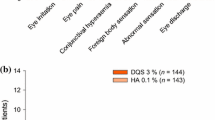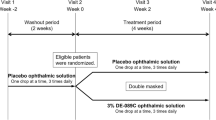Abstract
Introduction
This study aimed to investigate the tolerability of high-viscosity diquafosol tetrasodium (DQS) ophthalmic solution (DIQUAS LX; DQSLX) and examine its usability and effect on clinical findings in patients with dry eye disease (DED).
Methods
This interventional retrospective study included 66 eyes of 66 patients with DED who switched from conventional DQS to DQSLX ophthalmic solution. Tear function assessments (tear film breakup time [BUT], keratoconjunctival vital staining [VS] score), evaluations of DED symptom relief, and a four-item usability questionnaire (“comfort upon instillation,” “irritation upon instillation,” “eye mucus discharge,” “convenience of instillation frequency”) assessed using a visual analog scale from 0 (worst) to 10 (best) were administered 4 weeks after switching to DQSLX. Factors associated with drug tolerability were assessed using multiple regression analysis.
Results
The symptoms improved by 64.2% after switching to DQSLX. The BUT value, VS score, and the questionnaire items “comfort upon instillation” and “convenience of instillation frequency” were significantly improved after switching to DQSLX. DQSLX tolerability was reported as acceptable in 56 (84.8%) and unacceptable in 10 (15.2%) patients. Overall, DQSLX tolerability was significantly associated with “comfort upon instillation” and “convenience of instillation frequency” and tended to be associated with a VS score ≥ 1. DQSLX tolerability depended on symptom and VS score improvements and absence of excessive “eye mucus discharge” in patients with a VS score ≥ 1 (39 patients), but on “comfort upon instillation” and absence of excessive “eye mucus discharge” in patients with a VS score = 0 (27 patients).
Conclusion
The high-viscosity DQSLX ophthalmic solution was generally considered acceptable in the study population. However, drug tolerability seemingly differed between patients with DED with and without epithelial damage. The former were affected by improvements in symptoms and clinical findings, whereas the latter were affected by comfort upon instillation.
Trial Registration
University Hospital Medical Information Network identifier, UMIN000051390.
Similar content being viewed by others
References
Watanabe H. Significance of mucin on the ocular surface. Cornea. 2002;21:S17-22.
Gipson IK, Argüeso P. Role of mucins in the function of the corneal and conjunctival epithelia. Int Rev Cytol. 2003;231:1–49.
Jumblatt MM, McKenzie RW, Jumblatt JE. MUC5AC mucin is a component of the human precorneal tear film. Invest Ophthalmol Vis Sci. 1999;40:43–9.
Govindarajan B, Gipson IK. Membrane-tethered mucins have multiple functions on the ocular surface. Exp Eye Res. 2010;90:655–63.
Lau OC, Samarawickrama C, Skalicky SE. P2Y2 receptor agonists for the treatment of dry eye disease: a review. Clin Ophthalmol. 2014;8:327–34.
Keating GM. Diquafosol ophthalmic solution 3 %: a review of its use in dry eye. Drugs. 2015;75:911–22.
Yokoi N, Georgiev GA. Tear film-oriented diagnosis and tear film-oriented therapy for dry eye based on tear film dynamics. Invest Ophthalmol Vis Sci. 2018;59:DES13–22.
Tauber J, Davitt WF, Bokosky JE, et al. Double-masked, placebo-controlled safety and efficacy trial of diquafosol tetrasodium (INS365) ophthalmic solution for the treatment of dry eye. Cornea. 2004;23:784–92.
Bremond-Gignac D, Gicquel JJ, Chiambaretta F. Pharmacokinetic evaluation of diquafosol tetrasodium for the treatment of Sjögren’s syndrome. Expert Opin Drug Metab Toxicol. 2014;10:905–13.
Shigeyasu C, Yamada M, Akune Y, Fukui M. Diquafosol for soft contact lens dryness: clinical evaluation and tear analysis. Optom Vis Sci. 2016;93:973–8.
Jeon HS, Hyon JY. The efficacy of diquafosol ophthalmic solution in non-Sjögren and Sjögren syndrome dry eye patients unresponsive to artificial tear. J Ocul Pharmacol Ther. 2016;32:463–8.
Uchino M, Yokoi N, Shimazaki J, Hori Y, Tsubota K, Japan Dry Eye Society. Adherence to eye drops usage in dry eye patients and reasons for non-compliance: a web-based survey. J Clin Med. 2022;11:367.
Suknuntha K, Tantishaiyakul V, Worakul N, Taweepreda W. Characterization of muco- and bioadhesive properties of chitosan, PVP, and chitosan/PVP blends and release of amoxicillin from alginate beads coated with chitosan/PVP. Drug Dev Ind Pharm. 2011;37:408–18.
van Bijsterveld OP. Diagnostic tests in the sicca syndrome. Arch Ophthalmol. 1969;82:10–4.
Baszkin A, Proust JE, Boissonnade MM. Adsorption of bovine submaxillary mucin on silicone contact lenses grafted with poly(vinyl pyrrolidone). Biomaterials. 1984;5:175–9.
Kurose M, Meng ID. Dry eye modifies the thermal and menthol responses in rat corneal primary afferent cool cells. J Neurophysiol. 2013;110:495–504.
Kovács I, Luna C, Quirce S, et al. Abnormal activity of corneal cold thermoreceptors underlies the unpleasant sensations in dry eye disease. Pain. 2016;157:399–417.
Bereiter DA, Rahman M, Thompson R, Stephenson P, Saito H. TRPV1 and TRPM8 channels and nocifensive behavior in a rat model for dry eye. Invest Ophthalmol Vis Sci. 2018;59:3739–46.
Masuoka T, Yamashita Y, Nakano K, et al. Chronic tear deficiency sensitizes transient receptor potential vanilloid 1-mediated responses in corneal sensory nerves. Front Cell Neurosci. 2020;14: 598678.
Toda I, Shimazaki J, Tsubota K. Dry eye with only decreased tear break-up time is sometimes associated with allergic conjunctivitis. Ophthalmology. 1995;102:302–9.
Tsubota K. Short tear film breakup time-type dry eye. Invest Ophthalmol Vis Sci. 2018;59:DES64–70.
Tsubota K, Yokoi N, Watanabe H, et al. A new perspective on dry eye classification: proposal by the Asia Dry Eye Society. Eye Contact Lens. 2020;46:S2-13.
Kaido M, Inoue S, Kawashima M, Ishida R, Nakamura S, Tsubota K. Role of transient receptor potential melastatin 8 activity in menthol-induced cold sensitivity and its qualitative perception in dry eye. Ocul Surf. 2021;19:307–12.
Marmalidou A, Kheirkhah A, Dana R. Conjunctivochalasis: a systematic review. Surv Ophthalmol. 2018;63:554–64.
Suzuki T, Kitazawa K, Cho Y, et al. Alteration in meibum lipid composition and subjective symptoms due to aging and meibomian gland dysfunction. Ocul Surf. 2022;26:310–7.
Medical Writing, Editorial, and Other Assistance
English language editing, funded by the authors, was provided by Editage (http://www.editage.jp).
Funding
This study did not receive any specific grants from funding agencies in the public, commercial, or not-for-profit sectors. The journal’s Rapid Service Fee will be funded by the authors.
Author information
Authors and Affiliations
Contributions
Conception and design of the study: Minako Kaido. Analysis and interpretation of results: Minako Kaido. Manuscript preparation: Minako Kaido. Critical review of the article: Reiko Arita. Data acquisition: Minako Kaido. Provision of materials, patients, or resources: Minako Kaido. Statistical expertise, literature searches: Minako Kaido. Administrative, technical, or logistic support: Minako Kaido, Reiko Arita.
Corresponding author
Ethics declarations
Conflict of Interest
Santen Pharmaceutical Co., Ltd (Osaka, Japan) was not involved in the scientific content of the research project or the writing of the manuscript. Minako Kaido and Reiko Arita declare that they have no competing interests.
Ethical Approval
The study protocol was reviewed and approved by the Ethics Committee of the Institutional Review Board of the Itoh Clinic, Saitama, Japan (Registry ID: 2022-1205). All procedures were performed in accordance with the ethical standards of the responsible committee on human experimentation (institutional and national) and the Helsinki Declaration of 1964, as revised in 2013. Informed consent was obtained from all participants. This study was registered with the University Hospital Medical Information Network (Registry ID: UMIN000051390).
Data Availability
The datasets generated during and/or analyzed during the current study are available from the corresponding author on reasonable request.
Rights and permissions
Springer Nature or its licensor (e.g. a society or other partner) holds exclusive rights to this article under a publishing agreement with the author(s) or other rightsholder(s); author self-archiving of the accepted manuscript version of this article is solely governed by the terms of such publishing agreement and applicable law.
About this article
Cite this article
Kaido, M., Arita, R. Effects of a Long-Acting Diquafosol Ophthalmic Solution on the Ocular Surface, Tolerability, and Usability in Dry Eye Disease. Adv Ther (2024). https://doi.org/10.1007/s12325-024-02871-4
Received:
Accepted:
Published:
DOI: https://doi.org/10.1007/s12325-024-02871-4




